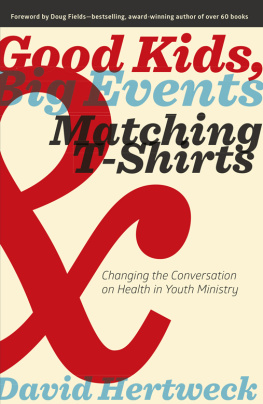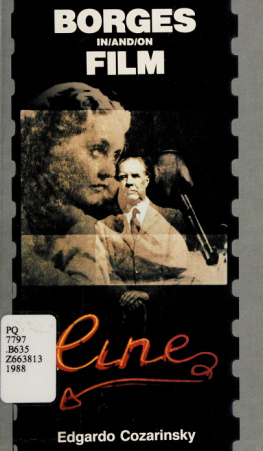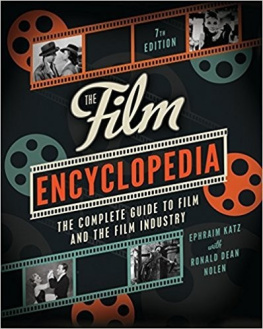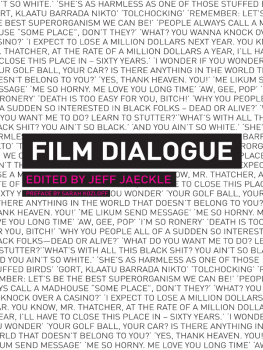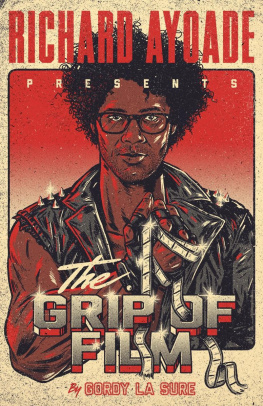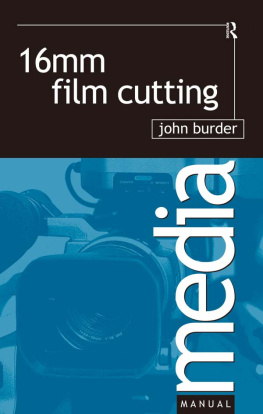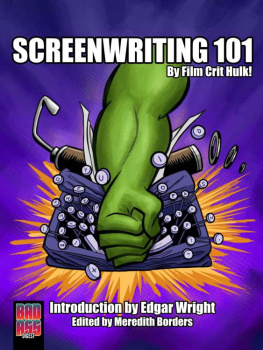Hertweck Tom - Food on Film
Here you can read online Hertweck Tom - Food on Film full text of the book (entire story) in english for free. Download pdf and epub, get meaning, cover and reviews about this ebook. year: 2014, publisher: Rowman & Littlefield Publishers, genre: Romance novel. Description of the work, (preface) as well as reviews are available. Best literature library LitArk.com created for fans of good reading and offers a wide selection of genres:
Romance novel
Science fiction
Adventure
Detective
Science
History
Home and family
Prose
Art
Politics
Computer
Non-fiction
Religion
Business
Children
Humor
Choose a favorite category and find really read worthwhile books. Enjoy immersion in the world of imagination, feel the emotions of the characters or learn something new for yourself, make an fascinating discovery.
- Book:Food on Film
- Author:
- Publisher:Rowman & Littlefield Publishers
- Genre:
- Year:2014
- Rating:5 / 5
- Favourites:Add to favourites
- Your mark:
- 100
- 1
- 2
- 3
- 4
- 5
Food on Film: summary, description and annotation
We offer to read an annotation, description, summary or preface (depends on what the author of the book "Food on Film" wrote himself). If you haven't found the necessary information about the book — write in the comments, we will try to find it.
Food on Film — read online for free the complete book (whole text) full work
Below is the text of the book, divided by pages. System saving the place of the last page read, allows you to conveniently read the book "Food on Film" online for free, without having to search again every time where you left off. Put a bookmark, and you can go to the page where you finished reading at any time.
Font size:
Interval:
Bookmark:
Food on Film
FILM AND HISTORY
Series Editor: Cynthia J. Miller
European Cinema after the Wall: Screening EastWest Mobility
edited by Leen Engelen and Kris Van Heuckelom
Native Americans on Network TV: Stereotypes, Myths, and the Good Indian
by Michael Ray FitzGerald
Bringing History to Life through Film: The Art of Cinematic Storytelling
edited by Kathryn Anne Morey
Hollywood and the End of the Cold War: Signs of Cinematic Change
by Bryn Upton
Smart Chicks on Screen: Representing Womens Intellect in Film and Television
edited by Laura Mattoon DAmore
The JFK Image: Profiles in Docudrama
by Raluca Lucia Cimpean
Food on Film: Bringing Something New to the Table
edited by Tom Hertweck
Food on Film
Bringing Something New to the Table
Edited by Tom Hertweck
Rowman & Littlefield
Lanham Boulder New York London
Published by Rowman & Littlefield
A wholly owned subsidiary of The Rowman & Littlefield Publishing Group, Inc.
4501 Forbes Boulevard, Suite 200, Lanham, Maryland 20706
www.rowman.com
16 Carlisle Street, London W1D 3BT, United Kingdom
Copyright 2015 by Rowman & Littlefield
All rights reserved. No part of this book may be reproduced in any form or by any electronic or mechanical means, including information storage and retrieval systems, without written permission from the publisher, except by a reviewer who may quote passages in a review.
British Library Cataloguing in Publication Information Available
Library of Congress Cataloging-in-Publication Data
Food on film : bringing something new to the table / edited by Tom Hertweck.
pages cm. (Film and history)
Includes bibliographical references and index.
ISBN 978-1-4422-4360-6 (hardback : alk. paper) ISBN 978-1-4422-4361-3 (ebook) 1. Food in motion pictures. I. Hertweck, Tom.
PN1995.9.F65F66 2015
791.43'6564dc23 2014028375
 The paper used in this publication meets the minimum requirements of American National Standard for Information SciencesPermanence of Paper for Printed Library Materials, ANSI/NISO Z39.48-1992.
The paper used in this publication meets the minimum requirements of American National Standard for Information SciencesPermanence of Paper for Printed Library Materials, ANSI/NISO Z39.48-1992.
Printed in the United States of America
To the teachers of food on film, who,
by bringing something new to the table in their own classes,
make us more attentive, more just,
and more wholly satisfied eaters and thinkers.
Contents
Acknowledgments
Thanks to the Film and History conference for creating a forumnot just for this material but for that of all interested film folk everywhere. It is one of the most welcoming, energetic conference experiences one can have, and cannot be recommended enough. Thanks to the original members of the food-and-film panels (Elisabeth, Deborah, Jessica, Memory, Chuck, Glenda, Mark, Jennifer, and Joshua Pederson) for their presentations that kicked off this project, as well as the many interested members of our audiences that spurred on the expansion of that work into the collection here. To those who chose to make the leap to the collection and to those who came aboard later, thanks for your work and also your attention to the labors of essaying on a deadline. One hears the horror stories of collections gone awry; this collection, happily, has not been one.
Additional thanks are also extended to Cheryll Glotfelty for her advice on managing the editorial work of a collection, all of which turned out to be sound. Special thanks (more than can properly be expressed here) are due to Elisabeth Buck: her leadership in the manuscript style made getting these essays on the road toward proper format a lot less painful than it could have been. Very special thanks to Jack Fredericks, who came through in the clutch and asked only for kale salad as payment; thanks as well to Robin Schifflin, who originally brought something to the table. Hearty appreciation is given to the Department of English at the University of Nevada, Reno, for support to travel to Film and History, as well as to the Bilinski Educational Foundation for the fellowship that, among other things, relieved teaching responsibilities at a key moment in this collections production.
Great thanks to Stephen Ryan at Rowman & Littlefield for his interest in food and film. Every book is a gamble for publishers, and Im delighted he saw us as a good bet. And finally, this collection would have been impossible without the kindly shepherding and sage advice of series editor Cindy Miller. Not only an insightful editor and a lively advocate for film studies, Cindy is a constant source of encouragement and good will, two things often lost in the sink-or-swim world of academe today. Thank you, thank you, thank you.
Introduction
Bringing Something New to the Table
Tom Hertweck
Without a doubt, food today has gone mainstream.
That may sound like a curious proposition: How can something that most people do multiple times a day be thought of as going mainstreamand, for that matter, how could it have ever been on the periphery? Instead, it might be better (though less flashily) said that thinking about food in the domain of popular culture has now taken up a substantial portion of our waking lives as both hobby and necessity. Slick magazinesfrom old warhorses Gourmet , Food & Wine , Saveur , and Bon Apptit , to the upstart Lucky Peach geared toward the hipster-foodiepeddle recipes, tales, and food porn pictures to readers often ill-equipped or even entirely uninterested in re-creating them. Popular press books collect the years best writing about food, while a new genrethe commodity historyhas been invented to make a space for increasing interest in the long histories of things we eat. Every content mill on the Internet, from the Huffington Post to Buzzfeed , has a food area that can contain as much material as the site can create. Some websites wholly devoted to au courant food culture, such as Eater.com, aggregate big issues to minutiae, to the degree that they keep track of chefs personal habits and financial lives in the same way celebrity watchers keep up with the Kardashians. Real eaters themselves have access to more reviews of more restaurants than at any other point in human history by several orders of magnitude. Even foods themselves are mottled with paratext, as packaging and stickers explain foods in the supermarket to you, the buyer, through creative, often complex narratives. If food had always been inescapable before as a means to keep one alive, food culture inasmuch as culture is thought made textis now inescapable as a means of locating things to eat. In other words, the answer to What are you eating? has gone from a one-word response to, frequently, a name, a story, a litany of facts, and a variety of ethical and nutritional positions. Food for thought has never rung more true.
At the same time, film, perhaps the most responsive and democratic of media forms, has always made a place for food. Indeed, filmnearly since its inceptionhas been a repository of attitudes toward and representations of food culture. From Mliss Le Voyage dans la Lune (1902) and its hand-painted, cheese-filled moon to Chaplins Modern Times (1936) and the Billows Feeding Machine to Ill have what shes having in When Harry Met Sally (1989), food has always found its way into the filmic scene. After all, every filmmaker knows that a way to add action to a scene heavy on dialogue is to place it in a diner, around a dinner table, or at a hot dog stand. Fans, too, have responded to food-films in ecstatic ways. An Internet search for food movies reveals hundreds of websites, listicles, and fan-pages devoted to the appreciation of food through film, and vice versa, not to mention Facebook groups, Tumblr feeds, and Pinterest accounts with active, running catalogs and commentary on cuisine in the movies. At the time of this writing, in fact, the Internet buzzes with enthusiasm for Jon Favreaus sleeper hit and paean to food trucks, Chef , and is beginning to rumble with excitement for the appealing, yet predictable, cross-cultural charm of Lasse Hallstrms Oprah-produced Hundred-Foot Journey . Both put food and our relationship to it front and center, and illustrate just how passionate or delightful our seemingly banal need to eat can be. Academic criticism of food and film has likewise been established in meaningful ways in recent years. Monographs, such as James R. Kellers Food, Film, and Culture: A Genre Study (2006) and Steve Zimmermans Food in the Movies (now in a second edition, 2010), as well as edited collections, such as Anne L. Bowers seminal Reel Food: Essays on Food and Film (2004), have detailed the topography of this rich and textured terrain, as have frequent articles on food-films in the established food studies journals (such as Gastronomica , Food, Culture & Society , and Digest ) and in film journals broadly.
Next pageFont size:
Interval:
Bookmark:
Similar books «Food on Film»
Look at similar books to Food on Film. We have selected literature similar in name and meaning in the hope of providing readers with more options to find new, interesting, not yet read works.
Discussion, reviews of the book Food on Film and just readers' own opinions. Leave your comments, write what you think about the work, its meaning or the main characters. Specify what exactly you liked and what you didn't like, and why you think so.



